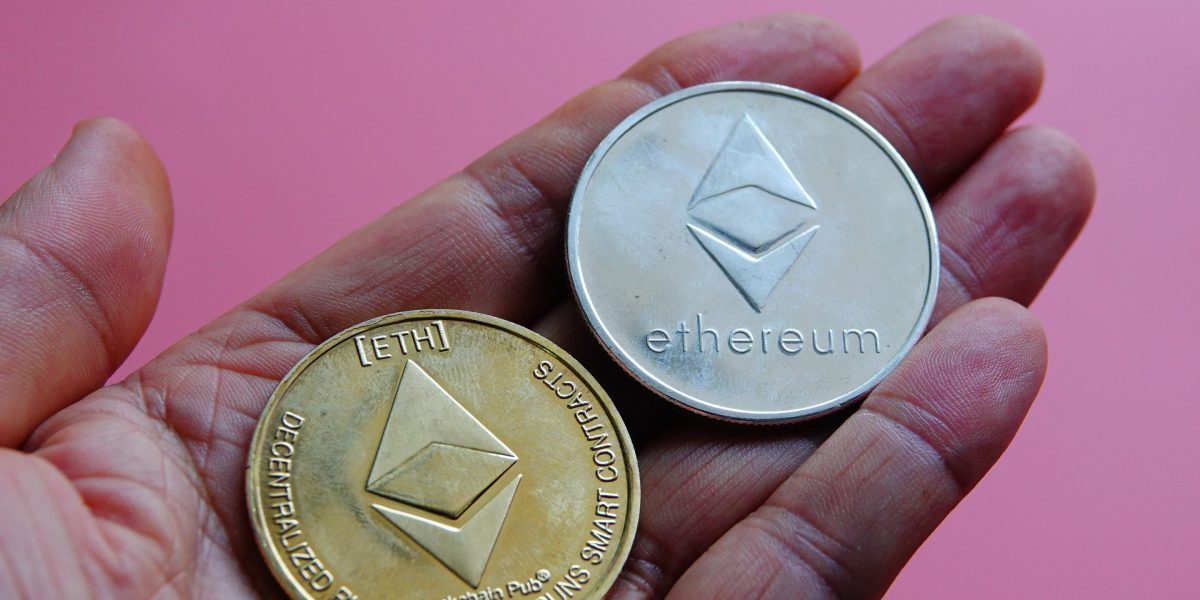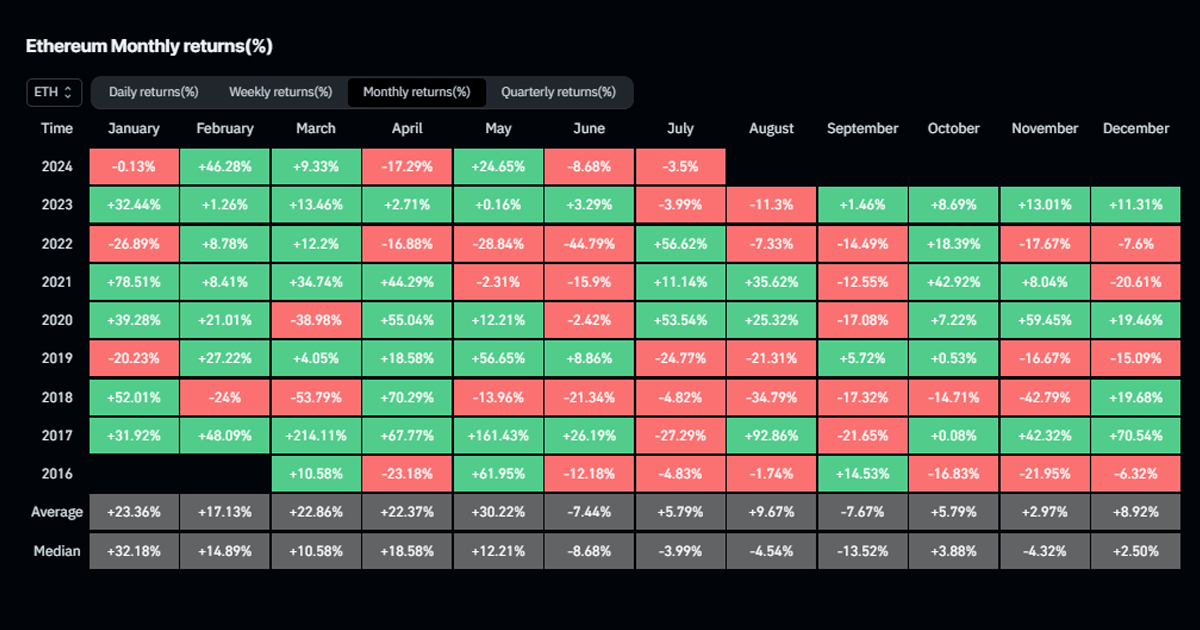Ethereum
Ethereum ETFs begin trading Tuesday. Here’s what you need to know.

New place ETF for EthereumThe two funds, which will allow investors to buy the second-most popular cryptocurrency in the form of shares, are expected to begin trading on Tuesday, July 23. The Securities and Exchange Commission has given the green light for at least three funds to go public that day, according to sources. told Reutersalthough it is estimated that a total of eight Ethereum ETFs will be launched simultaneously.
These instruments follow in the footsteps of the eleven Bitcoin spot ETFs. Having accumulated over $54 billion in assets under management since its launch in January, Bitcoin has soared 47% this year. Here’s everything you need to know about their Ethereum counterparts.
What is an Ether spot ETF?
Ether is the native cryptocurrency of the Ethereum blockchain. Despite the SEC’s decision ReservationsEther is legally considered a commodity, but the corresponding ETFs will be securities.
ETFs first came to market in 1993. These funds pool a basket of securities, such as a handful of different energy stocks, and are priced according to the indexes they track. They are listed on exchanges and can be traded during market hours, functioning like stocks.
Spot Ether ETFs will track the spot (or current) price of Ether. The products give investors access to the underlying cryptocurrency without the need to own a cryptocurrency wallet. The ETFs will be set up as grantor trusts, meaning investors will own a share of the Ether held by the trust.
Who issues them and what are the costs?
Eight asset managers are proposing to offer Ethereum ETFs: Black rockArk Invest/21Shares, VanEck, Grayscale, Fidelity, Bitwise, Franklin Templeton and Invesco/Galaxy Digital. Each instrument will be virtually identical, so the fees charged to investors are competitive. So far, we know that Franklin Templeton will charge 0.19%, VanEck 0.20%, and Invesco and Galaxy Digital will charge 0.25% for their jointly filed ETF.
The full list of fees will be revealed when the final registration statements, or S-1s, are filed with the SEC. That will happen Tuesday, if trading begins for all eight stocks.
Where can I access it?
They will be listed on the NasdaqChicago Board Options Exchange (CBOE) and New York Stock Exchange.
Why would someone buy an Ethereum ETF?
Bitcoin and Ether tokens represent units of ownership – and therefore value – of an underlying blockchain. Beyond that they are very different.
While Bitcoin can be a long-term hedge against inflation, Ethereum is closer to a technology investment. The main principle of blockchain is to “remove the middleman and enable 24/7 availability of financial services, such as trading and lending, in addition to tokenization, digital collectibles, and digital identity,” Vetle Lunde, senior analyst at K33 Research, told Fortune.
While cryptocurrency markets are currently highly correlated, that may not always be the case, he adds. As such, Ether ETFs allow investors to diversify which sectors of the crypto economy they want to invest in.
Will their popularity match that of spot Bitcoin ETFs?
Demand for these funds will be 20% higher than for spot Bitcoin ETFs, Bloomberg ETF analyst James Seyffart told Fortune. That’s because Ether’s market cap is about a third of Bitcoin’s. Plus, he adds, ETFs won’t benefit from a key advantage of holding Ether: Investors won’t be allowed to betthat generates returns. But even at this smaller size, they would be “extremely successful” by any ETF launch standard, Seyffart says. Similarly, K33 Research predicts that in the first six months of trading, capital inflows will amount to $4 billion, or a quarter of spot Bitcoin ETFs.
To judge their success, it’s critical to assess performance after six months of trading, rather than just “game day” and the first few weeks, Leah Wald, CEO and president of Cyberpunk Holdings Inc., told Fortune. Launched in the summer, they come to market at a time when trading is typically “more muted,” she said. Additionally, success should also be judged on volume and distribution, rather than just inflows, because the health of those metrics puts long-term AUM growth at the forefront, she added, as investors feel safe allocating dollars to these new names.
Who will invest in these projects?
Institutional investors, such as hedge funds, pension funds, banks and endowments. Retail investors will also have access, either by buying them directly or through portfolio allocations through wealth advisors. The latter group will likely dominate the first six months of trading, as T1 13F Bitcoin spot ETFs reveal that over 80% of total assets under management came from retail investors.
How will ETFs impact the cryptocurrency market?
If K33’s forecast of a $4 billion inflow over six months proves accurate, at current prices, that would mean 1% of all Ether in circulation would be absorbed by ETFs by the end of the year. That absorption is “well positioned” to bolster Ether’s price in the second half of the year, Lunde believes.
Inflows would also be bullish for the broader market, as history suggests. New money flowing into Bitcoin via ETFs has pushed the cryptocurrency market cap up 46% in 2024, according to K33. Lunde predicts that the products “could further add to the strength of the broader market” as they allow sidelined capital to enter the market. Additionally, Bitcoin ETF investors “have proven to handle volatility with grace, and flows have been strong even during deep corrections,” Lunde says, suggesting that ETFs can open the market to new, long-term investors.
Finally, the fact that BlackRock, a traditional financial giant, is issuing one of the funds shows that the firm is taking a closer look at cryptocurrencies. It gives the sector a “strong and much-needed stamp of approval,” he says.
Recommended newsletter:
CEO Daily provides essential context for the information business leaders need to know. Every weekday morning, more than 125,000 readers trust CEO Daily for insights into leaders and their businesses. Subscribe now.
Source
Ethereum
QCP sees Ethereum as a safe bet amid Bitcoin stagnation

QCP, a leading trading firm, has shared key observations on the cryptocurrency market. Bitcoin’s struggle to surpass the $70,000 mark has led QCP to predict Selling pressure is still strong, with BTC likely to remain in a tight trading range. In the meantime, Ethereum (ETH) is seen as a more promising investment, with potential gains as ETH could catch up to BTC, thanks to decreasing ETHE outflows.
Read on to find out how you can benefit from it.
Bitcoin’s Struggle: The $70,000 Barrier
For the sixth time in a row, BTC has failed to break above the $70,000 mark. Bitcoin is at $66,048 after a sharp decline. Many investors sold Bitcoin to capitalize on the rising values, which caused a dramatic drop. The market is becoming increasingly skeptical about Bitcoin’s rise, with some investors lowering their expectations.
Despite the continued sell-off from Mt. Gox and the US government, the ETF market remains bullish. There is a notable trend in favor of Ethereum (ETH) ETFs as major bulls have started investing in ETFs, indicating a bullish sentiment for ETH.
QCP Telegram Update UnderlinesIncreased market volatility. The NASDAQ has fallen 10% from its peak, led by a pullback in major technology stocks. Currency carry trades are being unwound and the VIX, a measure of market volatility, has jumped to 19.50.
The main factors driving this uncertainty are Value at Risk (VaR) shocks, high stock market valuations and global risk aversion sentiment. Commodities such as oil and copper have also declined on fears of an economic slowdown.
Additionally, QCP anticipates increased market volatility ahead of the upcoming FOMC meeting, highlighting the importance of the Federal Reserve’s statement and Jerome Powell’s subsequent press conference.
A glimmer of hope
QCP notes a positive development in the crypto space with an inflow of $33.7 million into ETH spot ETFs, which is giving a much-needed boost to ETH prices. However, they anticipate continued outflows of ETHE in the coming weeks. The recent Silk Road BTC moves by the US government have added to the market uncertainty.
QCP suggests a strategic trade involving BTC, which will likely remain in its current range, while ETH offers a more promising opportunity. They propose a trade targeting a $4,000-$4,500 range for ETH, which could generate a 5.5x return by August 30, 2024.
Ethereum
Ethereum Whale Resurfaces After 9 Years, Moves 1,111 ETH Worth $3.7 Million

An Ethereum ICO participant has emerged from nearly a decade of inactivity.
Lookonchain, a smart on-chain money tracking tool, revealed On X, this long-inactive participant recently transferred 1,111 ETH, worth approximately $3.7 million, to a new wallet. This significant move marks a notable on-chain movement, given the participant’s prolonged dormancy.
The Ethereum account in question, identified as 0xE727E67E…B02B5bFC6, received 2,000 ETH on the Genesis block over 9 years ago.

This initial allocation took place during the Ethereum ICOwhere the participant invested in ETH at around $0.31 per coin. The initial investment, worth around $620 at the time, has now grown to millions of dollars.
Recent Transactions and Movements
The inactive account became active again with several notable output transactions. Specifically, the account transferred 1,000 ETH, 100 ETH, 10 ETH, 1 ETH, and 1 more ETH to address 0x7C21775C…2E9dCaE28 within a few minutes. Additionally, it moved 1 ETH to 0x2aa31476…f5aaCE9B.
Additionally, in the latest round of transactions, the address transferred 737,995 ETH, 50 ETH, and 100 ETH, for a total of 887,995 ETH. These recent activities highlight a significant movement of funds, sparking interest and speculation in the crypto community.
Why are whales reactivating?
It is also evident that apart from 0xE727E67E…B02B5bFC6, other previously dormant Ethereum whales are waking up with significant transfers.
In May, another dormant Ethereum whale made headlines when it staked 4,032 ETHvalued at $7.4 million, after more than two years of inactivity. This whale initially acquired 60,000 ETH during the Genesis block of Ethereum’s mainnet in 2015.
At the time, this activity could have been related to Ethereum’s upgrade known as “Shanghai,” which improved the network’s scalability and performance. This whale likely intended to capitalize on the price surge that occurred after the upgrade.
Disclaimer: This content is informational and should not be considered financial advice. The opinions expressed in this article may include the personal opinions of the author and do not reflect the opinion of The Crypto Basic. Readers are encouraged to conduct thorough research before making any investment decisions. The Crypto Basic is not responsible for any financial losses.
-Advertisement-
Ethereum
Only Bitcoin and Ethereum are viable for ETFs in the near future

BlackRock: Only Bitcoin and Ethereum Are Viable for ETFs in the Near Future
Bitcoin and Ethereum will be the only cryptocurrencies traded via ETFs in the near future, according to Samara Cohen, chief investment officer of ETFs and indices at BlackRock, the world’s largest asset manager.
In an interview with Bloomberg TV, Cohen explained that while Bitcoin and Ethereum have met BlackRock’s rigorous criteria for exchange-traded funds (ETFs), no other digital asset currently comes close. “We’re really looking at the investability to see what meets the criteria, what meets the criteria that we want to achieve in an ETF,” Cohen said. “Both in terms of the investability and from what we’re hearing from our clients, Bitcoin and Ethereum definitely meet those criteria, but it’s going to be a while before we see anything else.”
Cohen noted that beyond the technical challenges of launching new ETFs, the demand for other crypto ETFs, particularly Solana, is not there yet. While Solana is being touted as the next potential ETF candidate, Cohen noted that the market appetite remains lacking.
BlackRock’s interest in Bitcoin and Ethereum ETFs comes after the successful launch of Ethereum ETFs last week, which saw weekly trading volume for the crypto fund soar to $14.8 billion, the highest level since May. The success has fueled speculation about the next possible ETF, with Solana frequently mentioned as a contender.
Solana, known as a faster and cheaper alternative to Ethereum, has been the subject of two separate ETF filings in the US by VanEck and 21Shares. However, the lack of CME Solana futures, unlike Bitcoin and Ethereum, is a significant hurdle for SEC approval of a Solana ETF.
Despite these challenges, some fund managers remain optimistic about Solana’s potential. Franklin Templeton recently described Solana as an “exciting and major development that we believe will drive the crypto space forward.” Solana currently accounts for about 3% of the overall cryptocurrency market value, with a market cap of $82 billion, according to data from CoinGecko.
Meanwhile, Bitcoin investors continue to show strong support, as evidenced by substantial inflows into BlackRock’s iShares Bitcoin Trust (NASDAQ: IBIT). On July 22, IBIT reported inflows of $526.7 million, the highest single-day total since March. This impressive haul stands in stark contrast to the collective inflow of just $6.9 million seen across the remaining 10 Bitcoin ETFs, according to data from Farside Investors. The surge in IBIT inflows coincides with Bitcoin’s significant $68,000 level, just 8% off its all-time high of $73,000.
Ethereum
Ethereum Posts First Consecutive Monthly Losses Since August 2023 on New ETFs

Available exclusively via
Bitcoin ETF vs Ethereum: A Detailed Comparison of IBIT and ETHA
Andjela Radmilac · 3 days ago
CryptoSlate’s latest market report takes an in-depth look at the technical and practical differences between IBIT and BlackRock’s ETHA to explain how these products work.
-

 Ethereum12 months ago
Ethereum12 months agoEthereum Posts First Consecutive Monthly Losses Since August 2023 on New ETFs
-

 Regulation12 months ago
Regulation12 months agoCryptocurrency Regulation in Slovenia 2024
-

 News12 months ago
News12 months agoNew bill pushes Department of Veterans Affairs to examine how blockchain can improve its work
-

 Regulation12 months ago
Regulation12 months agoThink You Own Your Crypto? New UK Law Would Ensure It – DL News
-

 Regulation12 months ago
Regulation12 months agoUpbit, Coinone, Bithumb Face New Fees Under South Korea’s Cryptocurrency Law
-

 Regulation12 months ago
Regulation12 months agoA Blank Slate for Cryptocurrencies: Kamala Harris’ Regulatory Opportunity
-

 Regulation12 months ago
Regulation12 months agoBahamas Passes Cryptocurrency Bill Designed to Prevent FTX, Terra Disasters
-

 Regulation12 months ago
Regulation12 months agoIndia to Follow G20 Policy for Cryptocurrency Regulation: MoS Finance
-

 News1 year ago
News1 year ago“Captain Tsubasa – RIVALS” launches on Oasys Blockchain
-

 Ethereum1 year ago
Ethereum1 year agoComment deux frères auraient dérobé 25 millions de dollars lors d’un braquage d’Ethereum de 12 secondes • The Register
-

 News12 months ago
News12 months agoEU supports 15 startups to fight online disinformation with blockchain
-

 News1 year ago
News1 year agoSolana ranks the fastest blockchain in the world, surpassing Ethereum, Polygon ⋆ ZyCrypto













